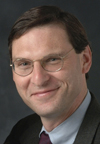|
 MUSC
President Dr. Ray Greenberg MUSC
President Dr. Ray Greenberg
As we start the new
academic and fiscal year, I am pleased to share with you some
perspectives on the state of the medical university. There probably is
no better place to start than with several recent assessments about how
our faculty, staff and students feel about the university. This year, a
campus survey revealed that 97 percent of faculty felt that they made
the right decision in selecting MUSC. The same survey found that 93
percent of staff members were happy to be working here, and 96 percent
of graduating students believed that they had made the right choice in
attending the medical university.
It is hard to imagine that
many campuses in this country have such high satisfaction rates among
all key constituent groups. While we know that there is still room for
improvement, it is clear that together, those who work and study here
have fostered an environment that is supportive and rewarding.
Admission to our
educational programs remains highly competitive, with record numbers of
applicants this year. Recently, we also learned that our medical school
ranks in the top 10 nationally in terms of the percentage of admitted
students who chose to enroll here. At the other end of the educational
process, our students in all schools excel on licensing/accreditation
exams, with an overall passing rate for first-time takers of 94 percent.
Our research programs
continue to thrive. While we do not have final numbers for the year
yet, it appears that our total research funding will be at or above our
record numbers last year. This success was achieved in spite of the
fact that the supplementary funding from the American Recovery and
Reinvestment Act ended, and through most of the year, there was much
uncertainty about the appropriation levels of most federal agencies.
In the clinical arena, the
demand for our services continues to be strong, with a growth in
hospital discharges of about 3 percent. Our patient satisfaction rate
is the sixth best out of 82 hospitals in the national University
Healthsystem Consortium. We were recognized as one of the most improved
hospitals in the country in a "Most Wired Health Care" award. As one
illustrative example, our stroke telemedicine program, which was
created three years ago, has provided more than 1,300 consultations to
a network that now includes 15 partner hospitals throughout the state.
On the financial front, in
spite of continuing declines in state appropriations, and most recently
reductions in Medicaid payments, we are holding our own. Although the
final audited numbers will not be known for several months, it appears
that all of our units will have met their operating budgets. This is a
tribute to all of our faculty and staff who are working so hard to "do
more with less."
Coming off of the
successful and early completion of our capital campaign, there was the
distinct possibility that our private fund-raising would dip this year.
The preliminary estimates, however, reveal that once again we will have
set a record in philanthropy. This support speaks volumes about the way
that the medical university is viewed within this community and beyond.
The university strategic
plan, with its four emphasis areas of entrepreneurism,
innovation/technology, globalization, and interprofessionalism,
continues to be developed by four faculty-led working groups. Progress
is being made already in several of these areas. For example, with
regard to globalization, we are launching a new certificate program in
global health, we have signed new partnership agreements with several
institutions abroad, and the Master of Science in Clinical Research is
now reaching an international audience. Many more initiatives will be
launched in all four strategic areas during the coming year, and I hope
that you will find ways to participate.
While much more could be
written about our progress in education, research, and patient care, I
have tried to share some sense of the overall momentum at the medical
university. Each year, I am awestruck by the accomplishments of our
faculty and staff in what can only be described as challenging
circumstances. You and your coworkers are making a huge difference, not
only in this institution, but more importantly among the people that we
serve. It is in that spirit that, in spite of continuing financial
pressures, we are able to offer pay-for-performance increases once
again this year. In the near future, each of the human resource
departments will be communicating with its respective constituents
about the particulars of its pay-for-performance plans.
It is with great
appreciation that I thank each and every one of you for all that you
do. May the coming year be one of continued success for you personally
and for all of us collectively.
With best wishes,
Ray Greenberg,
M.D., Ph.D.
MUSC President
|



